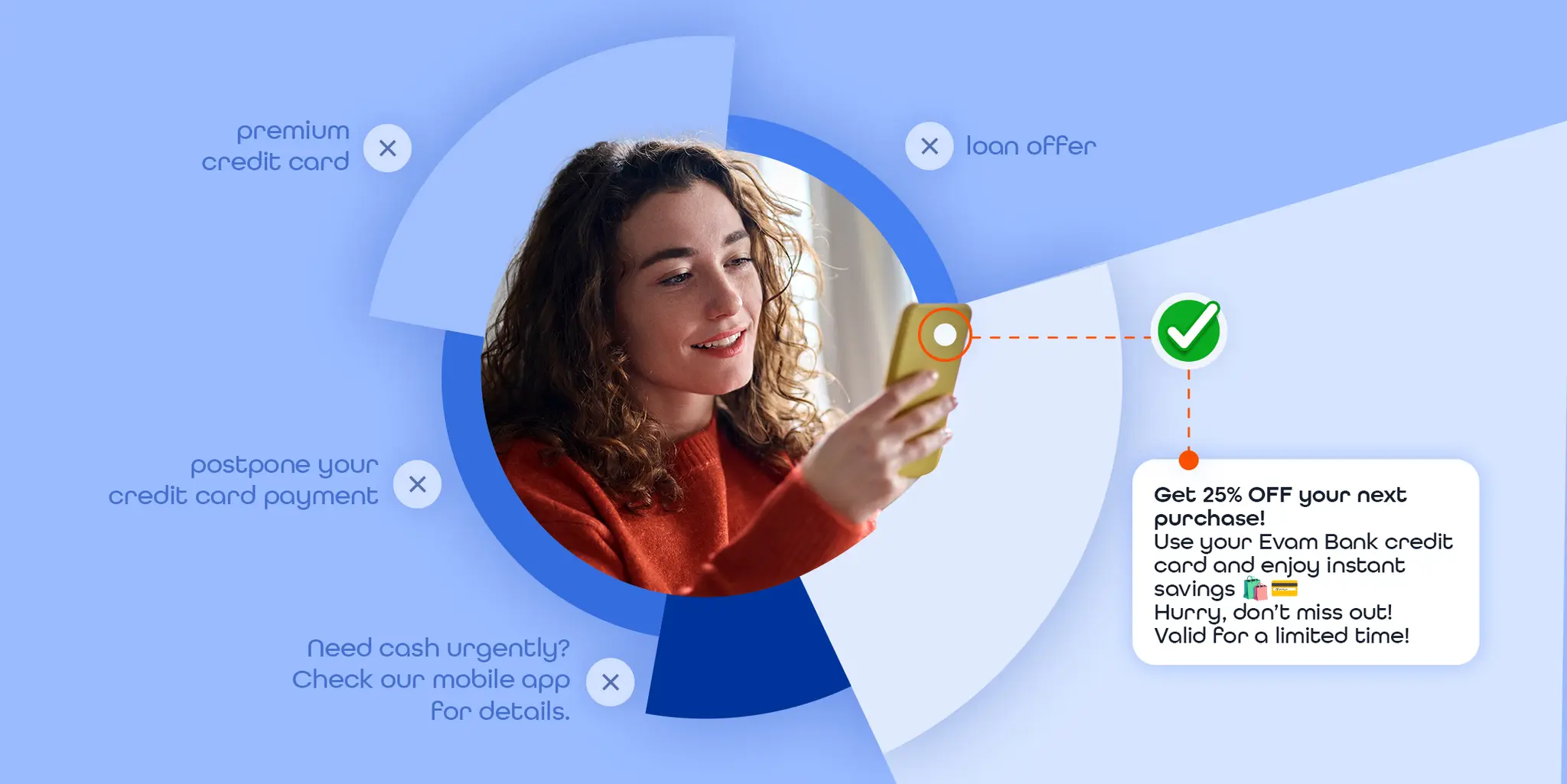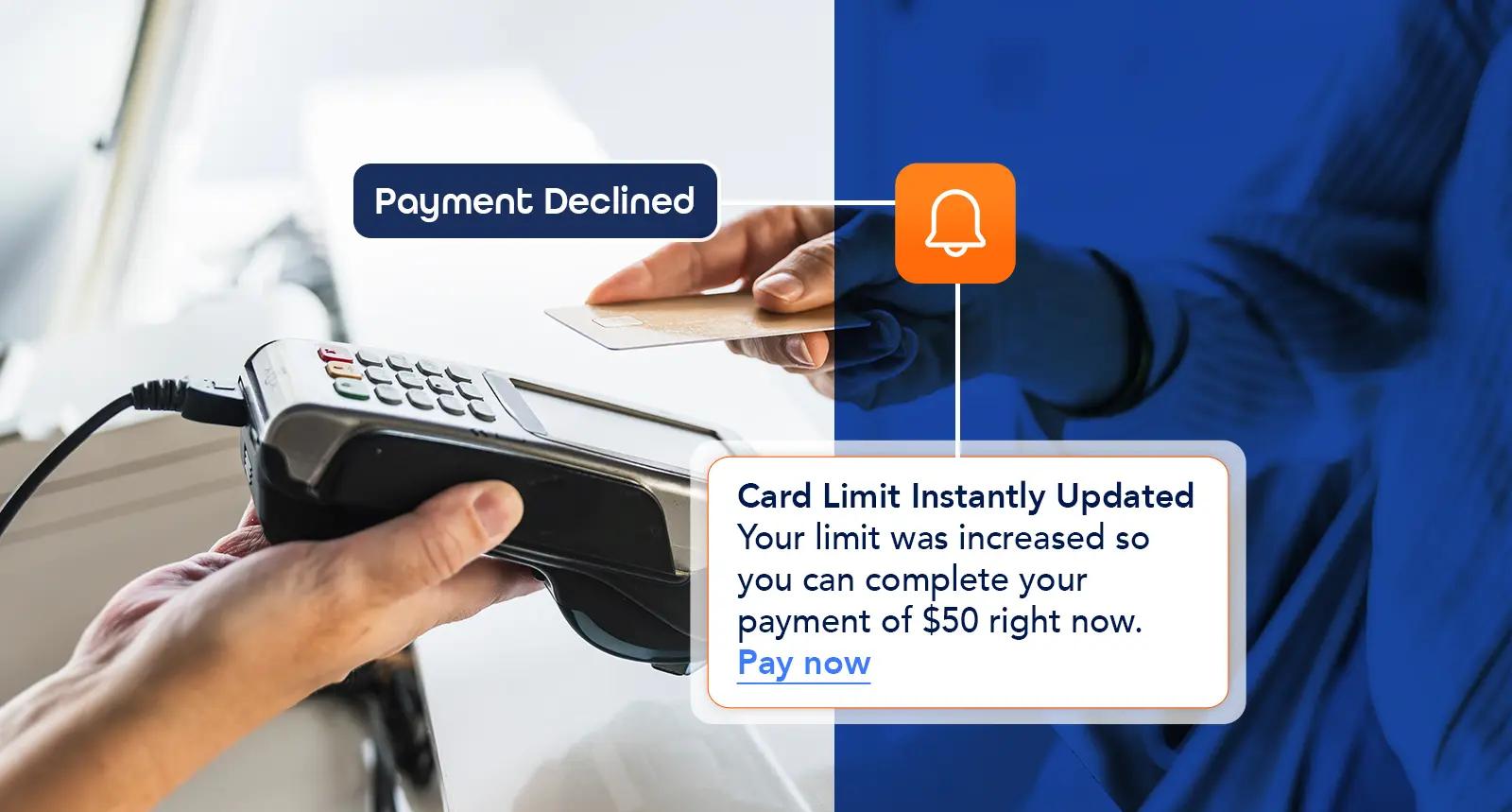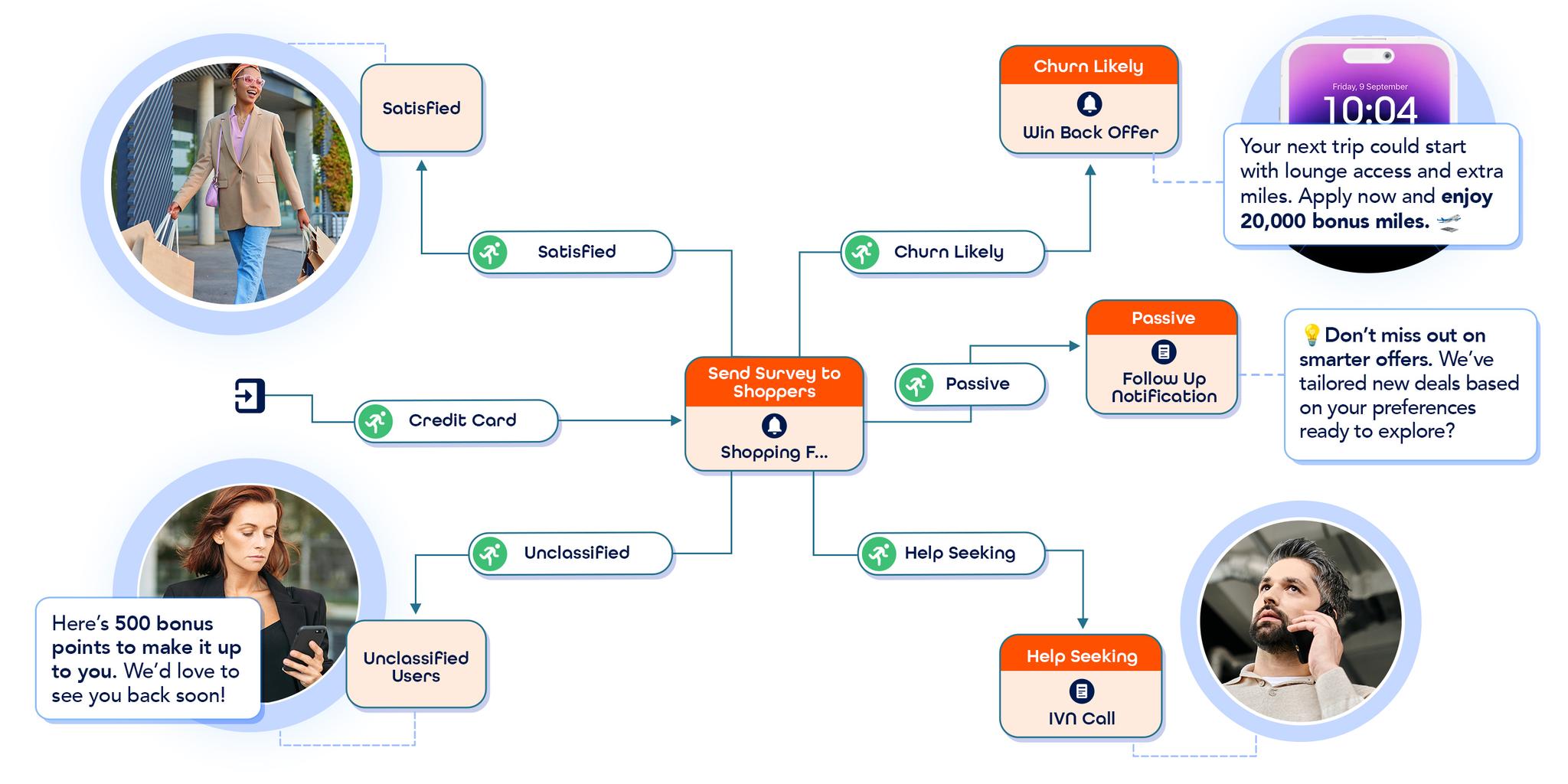- The Hidden Cost of Delayed Engagement: Why Real Time Matters More Than Ever
- What Is Delayed Engagement and Why Does It Happen?
- Delayed Engagement Consequences & Costs
- 1. Loss of Revenue
- 2. Decreased Customer Loyalty
- 3. Lower Conversion Rates
- 4. Operational Inefficiency
- 5. Damaged Brand Perception
- Why Real-Time Engagement Matters
- 1. Mobile-First Customers
- 2. AI & Automation Capabilities
- 3. Seamless Omnichannel CX
- What Real-Time Engagement Looks Like in Action
- 1. Immediate Response to Customer Actions
- 2. Personalized Interactions Across Channels
- 3. Proactive Recommendations
- 4. Enhanced Customer Support
- 5. Continuous Optimization
- How to Get There: The Infrastructure Behind Real-Time Engagement
- 1. Unified Data Layer
- 2. Real-Time Decisioning & AI
- 3. Omnichannel Orchestration
- 4. Automation & Scalability
- 5. Monitoring & Improving Performance
- evamX: Real‑Time Personalization that Converts without Complexity
Imagine that a customer browses your site, adds a product to their cart, then gets distracted - a meeting starts, a phone rings, life happens. Hours later, your brand follows up with a personalized email reminding them about the item they left behind. It’s well-crafted, data-driven, and beautifully designed.
But by the time it lands, it’s too late.
They’ve already bought the product from a competitor who popped up with a timely push notification and a limited-time offer within minutes of abandonment. That missed moment? It cost you a sale. But the ripple effect is bigger: it decreases customer loyalty, weakens your brand perception, and makes your next interaction feel less relevant.
In today’s attention economy, delayed engagement isn’t just a missed opportunity, it’s an active loss.
What Is Delayed Engagement and Why Does It Happen?
Delayed engagement happens when brands respond to customer behavior after the moment has passed, such as when the context has changed, the intent has cooled, or the customer has moved on.
It can be as simple as an email sent hours too late, a mobile push notification that never triggers, or a chatbot that routes queries through manual workflows before acting.
Despite advances in real-time marketing tech, many brands still rely on outdated systems that weren’t built for speed. Legacy infrastructure, batch-based data processing, disconnected channels, and manual campaign logic all contribute to lagging responses. This engagement latency causes brands to often engage with customers based on yesterday’s data, instead of what the customer is doing right now.
Delayed Engagement Consequences & Costs
The price of delayed engagement goes far beyond a single lost sale. It often impacts multiple areas of a business, from revenue to customer loyalty and brand reputation.
1. Loss of Revenue
The most obvious cost is direct revenue loss. If a business' messaging arrives too late, the customer may have already moved on by purchasing a product elsewhere, losing interest, or deciding against the offer. Customer journey timing is crucial for seizing opportunities to close deals when customers are at the peak of their interest.
2. Decreased Customer Loyalty
Customers are more loyal to brands that provide personalized and timely experiences. When a brand lacks real-time customer engagement, it can leave consumers feeling unimportant or ignored. Delayed engagement only strengthens the perception that a brand is not listening, and over time, this can destroy hard-won loyalty and lead to churn.
3. Lower Conversion Rates
Delayed engagement directly impacts conversion rate optimization. The longer a brand waits to act on customer intent, the less likely it is that the customer will complete their purchase or take the desired action. By failing to engage in real time, brands risk losing valuable opportunities and seeing significant drops in conversions across the funnel.
4. Operational Inefficiency
Delayed engagement is a symptom of larger operational inefficiencies. For many brands, a lag in response time means teams are scrambling to catch up by manually re-engaging leads, retrofitting outreach, or resorting to batch-and-blast campaigns. These efforts are not only costly, but are far less effective than real-time omnichannel engagement.
5. Damaged Brand Perception
In today’s market, brand perception is everything. A slow response time, outdated messaging, or irrelevant promotions can make a brand seem out of touch or lazy. When customers don’t feel engaged in the moment by a brand, they start to wonder whether that brand is the right choice at all. With the stakes so high, it’s clear that delayed engagement doesn’t just cost businesses a sale, it can cost a relationship with a customer entirely.
Why Real-Time Engagement Matters
As customer expectations evolve, they’ve come to expect instant, personalized experiences at every touchpoint. The demand for real-time engagement is no longer a trend, it’s a business imperative for various reasons:
1. Mobile-First Customers
Consumers are increasingly mobile-first, often making decisions anywhere in the blink of an eye. Whether it’s responding to an abandoned cart, reacting to an urgent query, or delivering a personalized recommendation, the window of opportunity for engaging customers is narrow. That’s why it’s crucial for businesses to adopt real-time personalization strategies to effectively engage mobile app users.
2. AI & Automation Capabilities
The rise of AI and automation has raised the bar for personalization, making real-time engagement not just a benefit but a necessity. Brands that leverage AI insights and real-time data to fuel dynamic and contextually relevant interactions are outperforming those that don't. Agility, combined with precision, is what drives loyalty, increases conversions, and sets brands apart in a crowded marketplace.
3. Seamless Omnichannel CX
Whether customers are browsing on their mobile device, interacting with a chatbot, or receiving an email offer, real-time engagement is critical for ensuring that these touchpoints feel fluid and coherent. A delay in one channel can break the entire experience, leaving customers frustrated or confused. Real-time engagement allows brands to instantly sync interactions across all channels, delivering timely, personalized content no matter where the customer is.
What Real-Time Engagement Looks Like in Action
In practice, real-time engagement means responding instantly to customer actions with relevant, personalized content that adds value at exactly the right moment. This isn’t just about sending messages faster; it’s about using real-time data, AI, and automation to create the right interaction every time.
1. Immediate Response to Customer Actions
When a customer abandons a cart or browses a product, they expect a timely response. Real-time engagement allows brands to trigger instant follow-ups, whether it’s through an email, push notification, or a targeted ad. The key is to act within moments of the customer’s behavior, while their interest is still fresh, and present an offer that makes sense in context.
2. Personalized Interactions Across Channels
Whether it's on social media, email, a website, or a mobile app, real-time engagement ensures consistency and personalization across every channel. This omnichannel approach lets brands speak to customers in a way that feels natural and seamless, regardless of the platform. With real-time data, brands can adjust their messaging based on the user’s activity and deliver behavior-triggered campaigns.
3. Proactive Recommendations
Using AI and machine learning, real-time engagement allows brands to go beyond reactive communication. With predictive insights, businesses can suggest products, content, or services based on real-time behavior, not just past interactions.
4. Enhanced Customer Support
AI-powered chatbots and virtual assistants have come a long way, offering real-time and conversational interactions that feel personalized. Whether answering questions or guiding customers through the purchasing process, these systems can offer support instantly, 24/7. With advancements in NLP (Natural Language Processing) and sentiment analysis, these systems not only respond to queries, but also adjust their tone and responses based on customer emotions and intent.
5. Continuous Optimization
With every interaction, data is collected and analyzed to refine future engagement strategies. Brands that get it right are constantly learning from every customer interaction, adjusting offers, timing, and channels to improve results over time. The more agile and adaptive a brand is, the more it can maximize the potential of real-time engagement.
How to Get There: The Infrastructure Behind Real-Time Engagement
Achieving true real-time engagement requires the right combination of technology, strategy, and data infrastructure. While the promise of providing a customer experience in real-time is clear, the path to delivering it consistently and effectively is more complex.
Here’s a look at the critical components that make real-time engagement possible:
1. Unified Data Layer
The backbone of real-time engagement is a unified data layer. Real-time marketing requires that customer data be seamlessly collected, integrated, and analyzed across all touchpoints. Without this unified data layer, businesses risk acting on outdated or siloed information, which can lead to slow responses and irrelevant engagement. A solid data architecture ensures that businesses can pull in real-time data, update customer profiles, and trigger the right interactions instantly.
2. Real-Time Decisioning & AI
Real-time decisioning systems analyze patterns, predict behavior, and deliver personalized messages or offers based on the customer’s current state and historical context. The role of AI here is pivotal. It doesn’t just help brands respond to customer actions, it anticipates needs, optimizes interactions, and improves over time. A system that can instantly analyze behavioral signals and predict future actions is what turns real-time engagement from a concept into a competitive advantage.
3. Omnichannel Orchestration
Real-time engagement isn’t limited to just one channel. It must span across all customer touchpoints. This means businesses need to ensure omnichannel orchestration, which is the ability to deliver a cohesive, personalized experience across multiple platforms such as email, SMS, social media, and mobile apps. Omnichannel platforms allow brands to sync customer data and orchestrate campaigns that can reach the customer wherever they are, at the moment they’re most likely to engage.
4. Automation & Scalability
To deliver real-time engagement at scale, automation is essential. Automated systems ensure that interactions occur as soon as the trigger event happens, speeds up responses, and provides consistency across all channels. Additionally, systems need to be scalable to handle large volumes of customer data and interactions without slowing down. Whether you’re engaging with hundreds or millions of customers, your infrastructure must be able to support fast, accurate, and personalized communication at scale.
5. Monitoring & Improving Performance
Once the systems are in place, it’s essential to constantly monitor and optimize performance. Real-time engagement is a dynamic process. Customers’ needs and behaviors evolve over time, and so should a business' strategy. Using advanced analytics and feedback loops, brands must track the success of their real-time initiatives and make adjustments as needed.
evamX: The Power Behind Seamless & Real-Time Customer Experiences
Achieving true real-time engagement doesn’t have to be complicated. With evamX, we’ve designed an AI-powered, omnichannel platform that integrates everything you need to deliver personalized and timely experiences that drive meaningful results. Our platform is built to address the critical components of real-time engagement that we’ve discussed, making it easier for your business to scale and succeed.

It starts with a unified data layer that gathers and updates customer information across every interaction, ensuring you always have an accurate, up-to-date view of each individual. This allows you to make smarter and faster decisions.
With advanced AI and real-time decisioning, our platform analyzes customer behaviors in the moment, so you can send the right message at the right time whether it’s a personalized recommendation, a timely offer, or a simple follow-up. All of this happens automatically, allowing your team to focus on strategy while automation handles the rest.
We also understand the importance of omnichannel engagement, which is why our solution allows you to seamlessly connect with customers across all platforms, ensuring consistent and relevant communication no matter where your customers are.
Our platform is built to handle massive volumes of interactions, without sacrificing performance or personalization. And with real-time monitoring and KPI tracking, you’ll always have visibility into your campaigns, ensuring that you’re continuously optimizing and driving ROI.
At evam, we’re committed to helping you stay ahead of the curve and unlock the full potential of real-time engagement. Ready to get started? Request a demo or contact us today to see how our platform can transform your customer interactions and drive the results you’ve been looking for.








